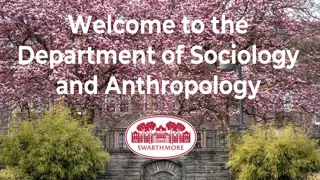Approaches to Health Disparities in Anthropology: Quantitative vs. Qualitative Methods
Exploring health in anthropology involves various factors like social, cultural, biological, and linguistic influences. This content delves into the quantitative research on disparities in health insurance coverage, particularly focusing on Latino vs. white respondents in Texas. The study utilized logistic regression analysis, revealing significant disparities even after controlling for socioeconomic and immigration status. The findings emphasize the importance of examining systemic influences on health disparities and suggest implications for institutional approaches to different populations.
Download Presentation

Please find below an Image/Link to download the presentation.
The content on the website is provided AS IS for your information and personal use only. It may not be sold, licensed, or shared on other websites without obtaining consent from the author.If you encounter any issues during the download, it is possible that the publisher has removed the file from their server.
You are allowed to download the files provided on this website for personal or commercial use, subject to the condition that they are used lawfully. All files are the property of their respective owners.
The content on the website is provided AS IS for your information and personal use only. It may not be sold, licensed, or shared on other websites without obtaining consent from the author.
E N D
Presentation Transcript
Quantitative and Qualitative Approaches to Health in Anthropology Ben Gonzalez
Outline Introduction What is medical anthropology? Why is health of interest to anthropologists? Quantitative methods Disparities in Context Qualitative methods Producing the Qualified Comparing and contrasting methods Moving forward with methods in health
Health in anthropology Medical anthropology Incorporates social, cultural, biological, and linguistic anthropology Factors which influence what we know as health Why health? Medicinal practices/beliefs Idea of the body Sociocultural norms Human health institutions Social construction of knowledge and politics of science
Disparities in Context- Quantitative Research Completed in Summer 2019 at University of Texas at Austin Part of independent NSF REU program Dealt with insurance coverage rates of Latino vs. white respondents in Texas Secondary data analysis Used existing data Research Questions: How are disparities in health insurance coverage distributed differently across public and private insurance types? How much of the disparity is related to socioeconomic status?
Disparities in Context- Methodology Data ACS 2017: Nationally representative sample by Census Bureau Individual-level data Texas residents ages 18-45 n=76,842 Methods Logistic regression 3 Outcome variables: whether or not respondent has any, public or private insurance Controlled for socioeconomic status, family structure and age, and immigration status Odds-ratios for Latino coverage vs. white
Disparities in Context- Results Findings After controlling for socioeconomic status (SES), still a large disparity in coverage Controlling for immigration status largely reduced the disparity These trends hold true across different types of insurance (but especially private) Implications There is more to health insurance disparities than class System avoidance Could inform how institutions approach different populations Benefits of quantitative study
Producing the Qualified- Qualitative Research Green and Healthy Homes (GHH) Lead-based paint removal and renovation program for San Antonio Families must meet specific requirements Income level Age of home Age of children in home (focus of study) Families must live in house for 5 years after renovation, or pay back cost Research questions How do environmental hazards constitute a public health threat, and how do public institutions systematize responses to that threat? How do requirements for public health programs inform our understanding and prioritization of public health itself?
Producing the Qualified- Methodology Community Data Interviews with 4 GHH residents Observational data on 30 homes Outreach events between city & community City Data 10 interviews with various city officials Lead inspection Outreach events between city & community Qualitative Data and Analysis: Required IRB approval Informants (anonymous) found through mix of city data, word of mouth, referrals Transcriptions and analysis Theoretical focus and development changed over time
Producing the Qualified- Results Focus on child s measurable health Blood Lead Levels (BLLs) Requirements for qualification Methods of recruitment Clients and Collective investments Residents not simple beneficiary, but entering into a contract 5-year covenant protects investment by city Success conditions of GHH programs Implications Neoliberal structure of state-funded aid Public health s focus on protecting bodies Benefits of qualitative analysis Research questions How do environmental hazards constitute a public health threat, and how do public institutions systematize responses to that threat? How do requirements for public health programs inform our understanding and prioritization of public health itself?
Comparing and Contrasting Methods Quantitative Qualitative More easily generalizable Can speak to broader trends across larger scope Can directly build off previous data More rigid structure Often less resource-intensive More focused Speaks in-depth but to a narrower scope Not as easily summarizable Looser, fluid theoretical structure Often more resource-intensive
Methods and Health in Anthropology Both method categories offer unique aspects to the study of health Measurable outcomes vs. the power of a narrative Future research Quantitative: Human health outcomes affected by climate change Medicare-for-all and its societal implications Qualitative: LGBTQ+ health identities and how bodies are conceptualized COVID-19 and social responsibility
Thank you! Any Questions? Ben Gonzalez bencruzgonzalez@gmail.com
Image credits Photos of Dignowity Hill: https://www.realtor.com/realestateandhomes-search/Dignowity-Hill_San-Antonio_TX https://www.sanantonio.gov/historic/scoutsa/HistoricDistricts/Dignowity-Hill All other images are researcher s own, or retrieved from pixabay.com under free for commercial or non-commercial use license























